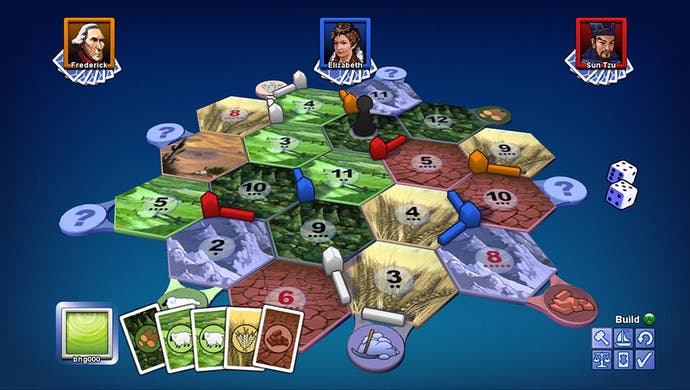Catan
Worth settling for?
First things first: some of us still have normal-person televisions. Catan is yet another game that completely ignores the fact that some people will need to play it on SDTV. Much of the text is tiny. Worse, it's tiny for no particular reason at all. Double-worse, it's actually pretty tiny on an HDTV, too.
This is criminally idiotic, and means Catan gets 0/10 immediately. Or would do, except that would be to play into its hands, wouldn't it? Trying to trick me, eh? Fortunately (for me and developer Big Huge Games), it's nigh-on impossible to ruin a game as tightly designed as The Settlers of Catan, the German hex-based board game on which Catan is based. Even if you try.
Need convincing? Well, it doesn't sound very exciting (for example, I've used the word "hex"), but when you put it under the magnifying glass (as some of us will have to - no I'm not going to stop grumbling about it), and put together a group with two or three other people, Catan is actually a fast-paced game of subtle depth.

On a randomly generated board featuring five kinds of resource tiles (sheep, wheat, wood, brick and ore) plus one desert tile on which a "robber" piece stands, players initially build two settlements and two roads each. From that point, the game progresses in a turn-based fashion, with players earning resources from the tiles adjacent to their settlements at the whim of a dice roll. Each turn, players can use their resources to build more roads or settlements, upgrade settlements into cities, or purchase "development cards", which offer powers, such as the ability to move the robber to steal resources from other players.
The game ends when one player reaches 10 victory points, with settlements each worth one victory point, cities two, and other achievements such as having the longest road worth more.
What makes the game particularly interesting is that on each turn players have the option of trading resources with each other to reach their individual goals. It's here that the game reveals its layers of depth - should you trade away two lumps of ore for one brick to build a road? Or should you save the ore to build a city, even though you currently lack the required wheat? Over and above that, what if the ore you trade away helps your opponent build a city?

With those variables and others in play, online games between friends quickly escalate into viciously Machiavellian backstabbing and double-crossing, which is as tense and enjoyable as a tight match in Gears of War. Of course, much like in Gears of War (they really are so similar), matches against random adversaries can be less successful. Lacking a lobby system, it can take irritatingly long to get into a workable game, and as a title that requires communicative, intelligent players to work, multiplayer can often be far more bother than it's worth. When it does work though, it offers one of the deepest multiplayer experiences on the Xbox 360.
Unfortunately, single-player mode doesn't fare as well. Featuring 13 different AI personalities based around famous leaders through history, such as Queen Elizabeth and Sun Tzu, and designed by Civilization II designer Brian Reynolds, the AI veers from stupidly compliant in easy mode to single-mindedly vindictive on hard, and with only two achievements to be specifically gained from single-player, it's not likely to be played for long (we know how you think). Considering how tightly designed the core game is, it's depressing to see that the designers chose not to include a deeper "campaign" mode featuring various win requirements (such as "win with no cities") or even a puzzle mode.
The achievements are a similarly uninspired range of timesinks, from "Acquire 100 resource cards in any game of Catan" to "Collect 1000 Victory Points in ranked match play".

Perhaps the biggest flaw though is that the controls never stop being cumbersome. With several important information screens requiring more than one button to be held to be seen (never mind a strange and convoluted "emoticon" system for multiplayer matches) I've often chosen not to bother looking up information that might come in handy rather than try to work through the required finger gymnastics. It hardly seems an ideal system.
Still, despite its many mistakes (it's worth mentioning some horrifically insipid music, too) the masterpiece of design that is The Settlers of Catan still shines through. It may be the best board games ever made, in fact, and even in this slightly crippled form, Catan is a unique strategy title with a multiplayer option that's often worth 800 points alone. Even if you do have to squint.

